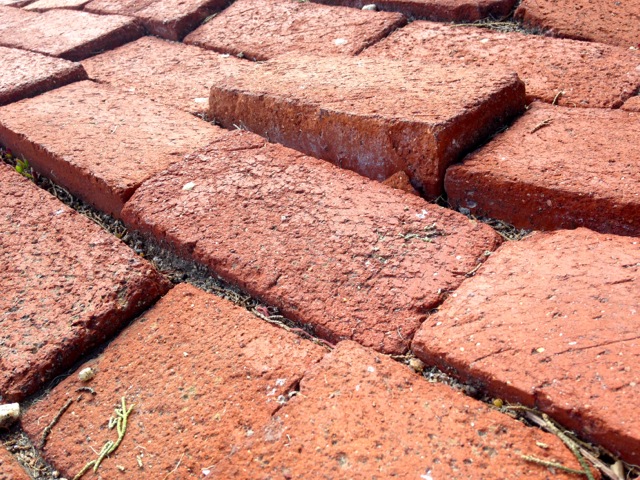There may not be a more concise and mature representation of Jeffers’ philosophy than the closing lines of this poem (SP 676):
We must uncenter our minds from ourselves;
We must unhumanize our views a little, and become confident
As the rock and ocean that we were made from.
Notice that Jeffers begins with an appeal to personal detachment from self; then he states that we need to unhumanize — but he qualifies the statement by adding on “a little.” These are the means. The end is confidence; not freedom from grief—not the peace of death. This is a moderate and positive formula.

Donnan’s path, Carmel Point: all their works dissolve.
The poem draws its “confidence” from the persistent beauty of the granite of Carmel Point. The case it makes, unfortunately, may be a little dated. It assures us that the beauty of the granite is “safe as the endless ocean,” but how safe is the ocean? Perhaps not as safe as it was in 1954. The granite may have been safer.
––––––––––––––––––––
Of more concern is a historical problem in the poem: it misrepresents the character of Carmel Point as Jeffers first saw it. Jeffers depicts his first impression of Carmel Point as follows:
- an unbroken field (no roads, buildings, greens, or sand pits)
- planted only with virgin vegetation (poppy and lupine)
- two or three horses; a few cows
- bounded (on the west) by clean cliffs
On point of fact, the field that Jeffers described as having been “walled with clean cliffs” had a road running between it and those “clean cliffs,” which may not have been perfectly clean, as we know that people did spend leisure time there; the Jeffers family, for instance, with their dogs—in the days before poop bags.
Furthermore, from 1912 to 1917, Carmel Point was a golf course. It was a rather primitive golf course whereon horses and milk cows would often graze, yet it was an engineered, maintained, and advertised golf course, complete with a clubhouse and water lines from the Hotel Del Monte water system. A quick look at the Carmel Pine Cone from the years 1915–17 makes it clear that this course was then the pride of Carmel.
It can be instructive to reflect upon the events that appear to have made it possible for Robin and Una Jeffers to purchase land and live comfortably on Carmel Point:
- The building of the Hotel Del Monte and the associated damming of the Carmel River … which provided the Point with a reliable water supply.
- The placement of a golf course at Carmel Point in 1912. This served to prevent residential development at the Point for over six years.
- World War I … and the resulting abandonment of the golf course at the Point.
- The construction of Pebble Beach Golf links at the opposite end of Carmel Beach … which rendered the Carmel Point course superfluous.
- The automobile.
None of this would have been an issue for the poem had it not taken a personal view. The Point would have appeared roughly as Jeffers described it a few years before he and Una arrived. I wonder whether Jeffers was consciously putting himself in Carmel before the golf course and even the sea road existed, or had the years—nearly 40 of them—so altered his first memories of the Point without his awareness?
Jeffers may have been living genuinely under an illusion that his wife had worked very hard to create and sustain. For thirty years: from 1919, the year that they moved in to Tor House, until Una was within a year of death (1949), Tor House had no electricity and was lit solely by kerosene lamps. This meant more work for Una. However, from 1920 onward, electricity was “next door” at Teddie Kuster’s house, and the word throughout Carmel is that Una would take her laundry to the Kuster house because Teddie had more than electricity: he had a washing machine. Whether this is factual I do not know, nor do I know over what years it might have occurred, nor how often, but I do know that Una worked hard to sustain Jeffers’ illusion of a genteel rural life of neither servants, nor beasts of burden, nor machines (other than the family car).
Una summed it all up in a 1934 letter:[1]
… I have said now and again—“If I can’t manage to give Robin an illusion of a wilder, more rural home, we’ll have to go elsewhere.” Somehow I’ve managed to give that illusion.
Carmel Point was just the stage for such an illusion, and 1919 was the perfect time to buy it.
Una would be gone by the end of 1950, but by then the boys were well into their thirties, and Robin would have Donnan and his wife Lee to look after the stonework, the laundry, and the cooking. There would be no rural illusion. It had died with Una. The house was wired and Carmel was closing in.
[1] May 27, 1934 Letter to Phoebe Barkan, cited by James Karman in Robinson Jeffers: Poet and Prophet, pg. 116. Also see Karman’s Collected Letters, Volume Two, pg. 319.
Carmel Point is included in the following anthologies:
- California Poetry: From the Gold Rush to the Present, 2003; ed. Dana Gioia, Chryss Yost, and Jack Hicks
- Twentieth-Century American Poetry, 2003; eds. Gioia, Mason, & Schoerke
- The Wild God of the World: An Anthology of Robinson Jeffers, 2003; ed. Albert Gelpi
- The Norton Anthology of Modern and Contemporary Poetry, Third Edition, 2003; eds. Ramazani, Ellman, & O’Clair
- The Selected Poetry of Robinson Jeffers, Stanford, 2001; ed. Tim Hunt
- The Norton Anthology of Poetry, 4th Edition, 1996; eds. Ferguson, Salter, & Stalworthy
- The Norton Anthology of Modern Poetry, Second Edition, 1988; eds. Ellman & O’Clair
- The Norton Anthology of Poetry, Shorter Edition, 1970
- Robinson Jeffers: Selected Poems, Vintage Books, 1965